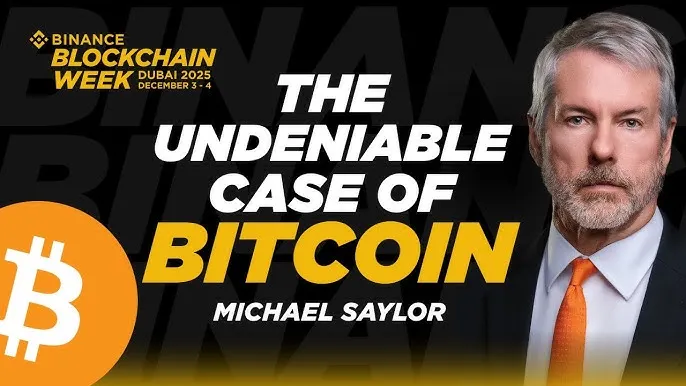What signals did the Federal Reserve’s latest Fintech meeting send?
- 核心观点:美联储正式接纳加密行业为金融合作伙伴。
- 关键要素:
- 推出精简版主账户降低接入门槛。
- 讨论稳定币合规与代币化发展路径。
- 确认AI与区块链融合的技术趋势。
- 市场影响:加速传统金融与加密资产融合进程。
- 时效性标注:中期影响
Original author: Sleepy.txt
Original Editor: Jack
On October 21, Washington, D.C., a conference room at Federal Reserve headquarters was filled with people who, just a few years ago, would have been considered troublemakers in the financial system.
The founder of Chainlink, the president of Circle, the CFO of Coinbase, and the COO of BlackRock sat face to face with Federal Reserve Governor Christopher Waller to discuss stablecoins, tokenization, and AI payments.
This was the Federal Reserve's first Payments Innovation Conference. While not open to the public, the event was livestreamed. The agenda featured four topics: the convergence of traditional finance and digital assets, stablecoin business models, the application of AI in payments, and tokenized products. Each of these topics represents a multi-trillion dollar market.
Waller opened his remarks by declaring, "This is a new era for the Federal Reserve in payments. The DeFi industry is no longer viewed with suspicion or ridicule." After this statement spread throughout the crypto community, Bitcoin rose 2 points that day. In his opening remarks, Waller also stated, "Innovation in payments is developing rapidly, and the Federal Reserve needs to keep pace."
This Payment Innovation Conference featured four roundtable discussions. Beating has summarized their content. The following are the core topics and content of the conference:
The Fed’s “slimming down the main account”
The most important thing Waller proposed is a concept called "lite master account".
A master account at the Federal Reserve serves as a bank's gateway to the Federal Reserve's payment system. With this account, banks can directly access payment rails like Fedwire and FedNow, bypassing intermediaries. However, obtaining a master account is challenging, and the approval process is lengthy. Many crypto companies have applied for years but haven't received one.
Custodia Bank is a prime example. This Wyoming-based crypto bank began applying for a master account in 2020, but the Federal Reserve delayed its application for over two years, ultimately leading to a lawsuit. Kraken also encountered similar issues.
Waller said many payment companies don't need the full functionality of a master account. They don't need to borrow money from the Federal Reserve or have daytime overdrafts; they just need access to the payment system. Therefore, the Fed is developing a "lite" version that would provide these companies with basic payment services while controlling risk.
Specifically, this account does not pay interest, may have a balance limit, cannot be overdrawn, and cannot borrow money, but its approval process will be much faster.
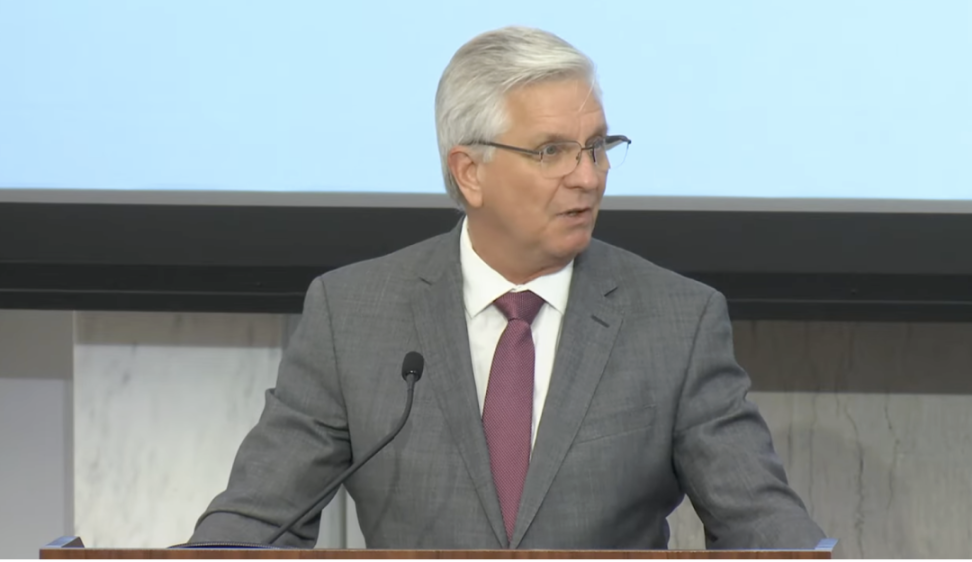
Federal Reserve Board Governor Waller
What does this proposal mean? Stablecoin issuers and crypto payment companies can directly access the Federal Reserve’s payment system without having to rely on traditional banks.
This will significantly reduce costs and improve efficiency. More importantly, this is the first time the Federal Reserve has officially recognized these companies as legitimate financial institutions.
Dialogue 1: Traditional Finance Collided with Digital Ecosystem
The first panel discussion focused on the convergence of traditional finance and the digital asset ecosystem. Moderated by Rebecca Rettig, Chief Legal Officer of Jito Labs, the panel featured Chainlink co-founder Sergey Nazarov, Lead Bank CEO Jackie Reseth, Fireblocks CEO Michael Shoroff, and Jennifer Buck, Global Head of Treasury Services and Depositary Receipts at Bank of New York Mellon.
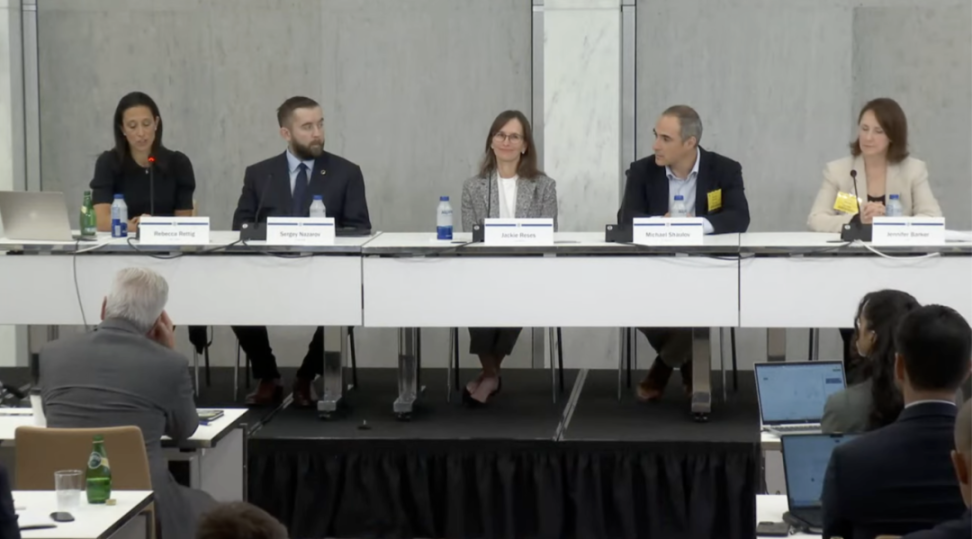
From left to right: Jito Labs Chief Legal Officer Rebecca Rettig, Chainlink co-founder Sergey Nazarov, Lead Bank CEO Jackie Reses, Fireblocks CEO Michael Shoroff, and Bank of New York Mellon's Global Head of Treasury Services and Depositary Receipts Jennifer Buck
Interoperability is the biggest obstacle to convergence
Chainlink co-founder Nazarov stated directly that the biggest challenge currently is interoperability. There is a lack of unified compliance standards, authentication mechanisms, and accounting frameworks between blockchain assets and traditional financial systems. As the cost of creating new chains decreases, chain fragmentation is increasing, making the need for unified standards even more urgent.
He urged the Federal Reserve to make the payment system interoperable with stablecoins and tokenized deposits. He said the payment sector represents the buyer side of the digital asset economy, and if the Federal Reserve can provide a clear framework for risk management, the United States can maintain its lead in global digital payment innovation.
He pointed out that a year ago, it was unimaginable that the Federal Reserve would discuss "regulated DeFi," which in itself marked a positive trend. Nazarov predicted that a hybrid model would emerge in the next two to five years: a "regulated DeFi variant," which would automate compliance processes through smart contracts.
Traditional banks are not ready yet. The core bottlenecks are cognition and talent.
Lead Bank CEO Reses believes that even with a blueprint for integrating traditional finance with the digital ecosystem, most banks are simply unprepared to handle this integration. Traditional banks lack wallet infrastructure, systems for processing cryptocurrency deposits and withdrawals, and internally lack talent who understand blockchain products.
She further attributes the problem to a gap in understanding and capabilities, emphasizing that the biggest obstacle isn't the technology itself, but rather the "knowledge and execution capabilities of the core banking and financial services teams." These core teams lack the ability to understand and judge emerging blockchain products, leaving them clueless about how to effectively regulate or oversee these new businesses.
This lack of preparedness is particularly evident on the retail side. Reses noted that while KYC systems for institutions are relatively mature, retail users still struggle to access these tools. This exposes an awkward reality: even if banks are willing to participate, their service capabilities are limited to a small number of institutional clients, and large-scale adoption is still a long way off.
The industry needs a pragmatic regulatory and risk control framework
The conversation also touched on the issue of AI fraud, which led to a discussion about the reversibility of on-chain transactions. Traditional wire transfers can be reversed, but blockchain transactions are final. Maintaining on-chain finality while meeting regulatory requirements for revocable processes presents a daunting challenge. Reses urged regulators to proceed "slow and steady," because "innovation is always great until your family gets scammed."
Fireblocks CEO Michael Shoroff steered the discussion toward deeper economic and regulatory issues. He noted that stablecoins could reshape credit markets and, in turn, influence the Federal Reserve's monetary policy. He also highlighted a specific regulatory ambiguity: the unclear responsibilities of banks when placing their tokenized deposits on public blockchains, a key issue currently hindering the progress of these projects. He called for further research into how digital assets might alter bank balance sheets and the Federal Reserve's role in this process.
Finally, Jennifer Buck from Bank of New York Mellon gave a "wish list" listing four issues that traditional banks hope regulators will prioritize: making the payment system operate 24 hours a day, developing technical standards, strengthening fraud detection, and establishing a liquidity and redemption framework for stablecoins and tokenized deposits.
Dialogue 2: Troubles and Opportunities of Stablecoins
The second panel focused on stablecoins. Moderated by Kyle Samani, co-founder of Multicoin Capital, the panel featured Charles Cascarilla, CEO of Paxos; Heath Tarbert, Chairman of Circle; Tim Spence, CEO of Fifth Third Bank; and Fernando Tres, CEO of DolarApp.
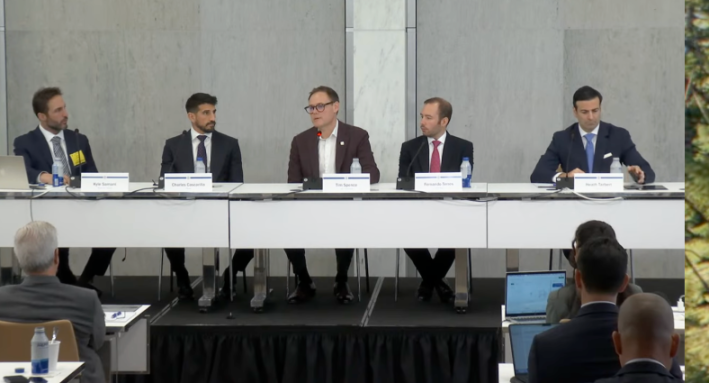
From left to right: Multicoin Capital co-founder Kyle Samani, Paxos CEO Charles Cascarilla, Fifth Third Bank CEO Tim Spence, DolarApp CEO Fernando Tres, Circle Chairman Heath Tarbert
Strong demand and use cases for compliant stablecoins
In July this year, the United States passed the GENIUS Act, requiring stablecoin issuers to hold 100% high-quality reserve assets, mainly cash and short-term U.S. Treasury bonds.
Since the bill came into effect, the proportion of compliant stablecoins has increased from less than 50% at the beginning of the year to 72%. Circle and Paxos have been the biggest beneficiaries. USDC's circulation reached $65 billion in the second quarter of this year, accounting for 28% of the global market, with year-to-date growth exceeding 40%.
Regarding use cases, Spence offered the most pragmatic view on behalf of the banks. He believed that the strongest and most immediate use case for stablecoins was cross-border payments, as it effectively addressed the pain points of traditional clearing delays and foreign exchange risks. In contrast, the programmability required for AI-based commerce was a more distant prospect.
Tres of DolarApp also added from the Latin American perspective that for these countries with unstable currencies, stablecoins are not a speculative tool but a necessary means of preserving value. This reminded the US-centered decision makers present that the application scenarios of stablecoins are far broader than they imagined.
The bottleneck of dial-up Internet access experience
Cascarilla identified the industry's biggest growing pains: user experience.
He compared the current DeFi and cryptocurrency to the early days of "dial-up Internet access", and bluntly stated that DeFi and cryptocurrency have not yet been fully abstracted.
He believes that mass adoption will only happen when blockchain technology is well abstracted and becomes "invisible." "No one knows how a mobile phone works... but everyone knows how to use it. Cryptocurrencies, blockchains, and stablecoins need to be like that."
Cascarilla praised companies like PayPal, arguing that their integration of stablecoins into traditional finance is an early sign of this shift in usability.
Threats to the banking system
Circle's Tarbert and Fifth Third Bank's Spence also participated in the discussion, representing the traditional banks' position, and their appearance itself is a signal.
Spence first tried to reshape the identity of banks. He proposed replacing "TradFi" (traditional finance) with "ScaledFi" (scaled finance), and said that the "old" identity of banks "is the least interesting thing."
He also pointed out that stablecoins will not deplete banks' "capital," but will deplete "deposits." The real threat is that if stablecoins are allowed to pay interest (even if disguised as "rewards" like Coinbase issuing USDC subsidies), it will pose a major threat to the formation of bank credit.
The core function of a bank is to absorb deposits and make loans (i.e., credit creation). If stablecoins, with their flexibility and potential interest, attract a large amount of deposits, banks' lending capacity will shrink, threatening the credit system of the entire economy. This is similar to the impact of early money market mutual funds (MMMFs) on the banking system.
Dialogue 3: AI Fantasy and Reality
The third panel discussion focused on AI. Moderated by Matt Marcus, CEO of Modern Treasury, the panel also included Cathie Wood, CEO of ARK Invest; Alessia Haas, CFO of Coinbase; Emily Sands, Head of AI at Stripe; and Richard Weidman, Head of Web3 Strategy at Google Cloud.
AI is ushering in the era of "agent business"
Cathie Wood predicts that AI-driven "proxy payment systems"—meaning AI is shifting from "knowing" to "acting," enabling users to make autonomous financial decisions (such as paying bills, shopping, and investing)—will unlock significant productivity. She asserts, "We believe that with such breakthroughs and the resulting productivity release, real GDP growth could accelerate to 7% or higher over the next five years."
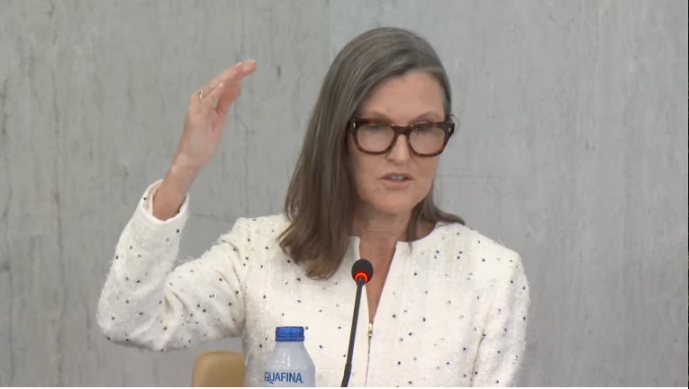
ARK Invest CEO Cathie Wood
Cathie Wood also cited AI and blockchain as the two most important platforms driving this wave of productivity. She reflected on US regulation, arguing that early hostility toward blockchain was a blessing in disguise, forcing policymakers to rethink and serving as a wake-up call for the US to regain its leadership in the "next generation internet."
Emily Sands of Stripe emphasized from a practical perspective that while use cases for AI-powered shopping agents (such as one-click checkout via ChatGPT) are emerging, mitigating fraud risk remains "one of the most pressing challenges." Merchants must clearly define how their systems interact with these AI agents to prevent new types of fraud.
AI has also achieved remarkable results in improving financial efficiency. Coinbase's Alessia Haas stated that by the end of the year, Coinbase expects half of its code to be written by AI robots, nearly doubling its R&D workforce. In financial reconciliation, processing crypto transactions takes one person half a day, while processing the same amount of fiat transactions would require 15 people over three days. This demonstrates how AI and crypto technologies have significantly reduced operational costs.
Stablecoins are the new financial infrastructure that AI agents urgently need
The second consensus from the discussion was that AI agents require a new, native financial tool, and stablecoins are a natural solution.
Richard Wiedemann of Google Cloud explained that AI agents can't open traditional bank accounts like humans, but they can have crypto wallets. Stablecoins offer a perfect solution for this, as they are programmable and particularly well-suited for AI-driven automated microtransactions (such as two-cent payments) and machine-to-machine (M2M) settlements.
Coinbase's Alessia Haas added that the programmability of stablecoins and the increasingly clear regulatory environment make them ideal for AI-driven transactions. The rapid monetization of AI companies (ARR growth is 3-4 times that of SaaS companies) also requires payment infrastructure to integrate new payment methods such as stablecoins.
At the same time, stablecoins and blockchain technology provide new fraud prevention tools, such as leveraging on-chain transaction visibility to train AI fraud models, address whitelisting/blacklisting mechanisms, and transaction finality (no chargeback risk for merchants).
Dialogue 4: Everything on the blockchain
The fourth panel discussion focused on tokenized products. Moderated by Colleen Sullivan, Head of Ventures at Brevan Howard Digital, the panel featured Franklin Templeton CEO Jenny Johnson, DRW CEO Don Wilson, BlackRock COO Rob Goodstein, and Kara Kennedy, Co-Head of Kinexys at JPMorgan Chase.
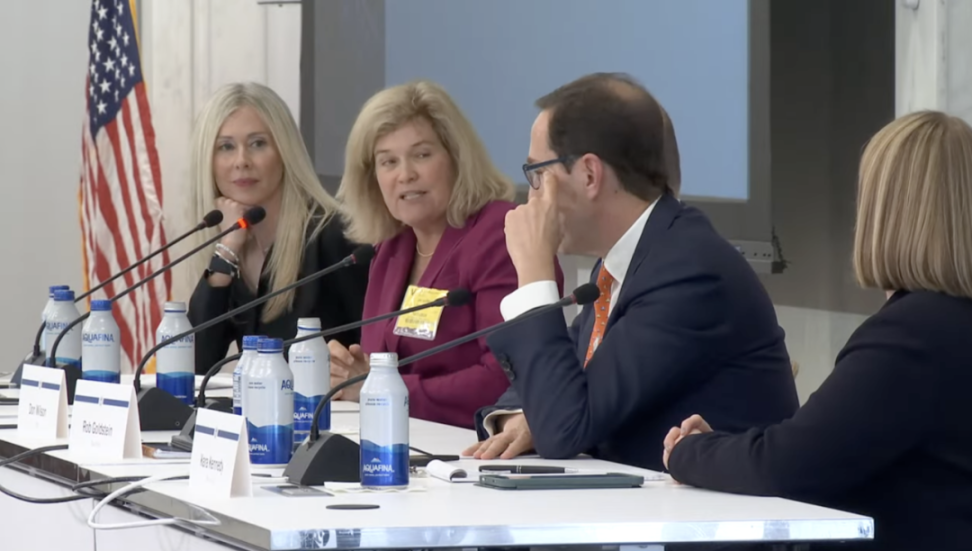
From left to right: BHD Colleen Sullivan, Franklin Templeton CEO Jenny Johnson, BlackRock COO Rob Goodstein, and JPMorgan Chase Kinexys Co-Head Kara Kennedy
It’s only a matter of time before traditional financial assets are put on the blockchain
Participants agreed that asset tokenization is an irreversible trend. BlackRock COO Goldstein offered the most direct statement: "It's not a question of if, but when." He pointed out that digital wallets already hold approximately $4.5 trillion, and this figure will continue to rise as investors gain direct access to tokenized stocks, bonds, and funds through blockchain portfolios.
DRW's Wilson is even more specific, predicting that within the next five years, every frequently traded financial asset will be traded on-chain. Franklin Templeton's Johnson likens this to historical technological changes, concluding, "Technology adoption always starts slower than people expect, and then suddenly takes off."
Tokenization isn't a distant vision; it's happening now. Currently, traditional finance and digital assets are merging in both directions: traditional assets (such as stocks and government bonds) are being tokenized and used in DeFi, while digital assets (such as stablecoins and tokenized money market funds) are also being integrated into traditional markets.
Institutions are already actively developing their strategies. Johnson revealed that Franklin Templeton has launched a native on-chain money market fund (MMF), which can calculate intraday returns with precision down to the second. Kennedy discussed JPMorgan Chase's Kinexys developments, including its use of tokenized US Treasury bonds for minute-by-minute overnight repos and the launch of a proof-of-concept for the JPMD deposit token. Wilson also confirmed that DRW is already participating in on-chain US Treasury bond repos.
Never replicate crypto-native “bad practices”
Despite the promising prospects, traditional financial giants remain highly vigilant about the risks. They emphasize that tokenized assets should not be interchangeable with stablecoins and deposit tokens, and that the market must evaluate the collateral "discount" of different assets based on credit quality, liquidity, and transparency.
BlackRock's Goodstein warned that we must be wary that many so-called "tokens" are actually complexly packaged "structured products" and that it is dangerous not to fully understand these structures.
DRW’s Wilson pointedly pointed out the serious problems exposed by the recent flash crash in the crypto market (October 11): unreliable oracles, and conflicts of interest such as internal liquidations and closure of user deposits by trading platforms for profit.
He strongly stated that these are "bad practices that traditional finance should not replicate" before entering DeFi, and that strict infrastructure oversight and market quality standards must first be established. In addition, for compliance (AML/KYC) requirements, regulated banks must use permissioned distributed ledgers (DLT).
Who is winning in the race for digital finance?
The signal from this meeting was clear: the Federal Reserve no longer views the crypto industry as a threat, but as a partner.
Over the past year or two, global competition in digital currencies has intensified. The digital RMB has made rapid progress in cross-border payments, with transaction volume expected to reach $870 billion in 2024. The EU's MiCA regulation has come into effect, and Singapore and Hong Kong are also developing their crypto regulatory frameworks. The United States is feeling the pressure.
However, the US policy differs. Rather than promoting a government-led central bank digital currency, it embraces private sector innovation. The Anti-CBDC Surveillance State Act, passed this year, explicitly prohibits the Federal Reserve from issuing a digital dollar. The US logic is to let companies like Circle and Coinbase develop stablecoins, while BlackRock and JPMorgan Chase handle tokenization, with the government solely responsible for setting rules and oversight.
The most direct beneficiaries are compliant stablecoin issuers. The valuations of Circle and Paxos have surged significantly in the past few months. Traditional financial institutions are also accelerating their deployment. JPMorgan Chase's JPM Coin has processed over $300 billion in transactions. Citigroup and Wells Fargo are both testing digital asset custody platforms.
Data shows that 46% of US banks now offer cryptocurrency-related services to their clients, compared to just 18% three years ago. The market response has been significant. Since the Federal Reserve signaled regulatory easing in April, the size of the stablecoin market has surged from over $200 billion at the beginning of the year to $307 billion.
This strategy is driven by deep political and economic considerations. Central bank digital currencies imply direct government oversight of every transaction, a difficult proposition to accept in American political culture. In contrast, private sector-led stablecoins maintain the dollar's global status while avoiding the controversy surrounding excessive government power.
However, this strategy also carries risks. Private stablecoin issuers could create new monopolies, and their collapse could trigger systemic risks. Finding a balance between encouraging innovation and mitigating risks is a challenge facing US regulators.
In his closing remarks, Waller said consumers don't need to understand these technologies, but ensuring they are safe and efficient is everyone's responsibility. This sentence sounds like official language, but the signal it sends is clear: the Federal Reserve has decided to integrate the crypto industry into the mainstream financial system.
This meeting did not issue any policy documents or make any decisions. But the signal it sent was more powerful than any official document. An era of dialogue has begun, and the era of confrontation has ended.


